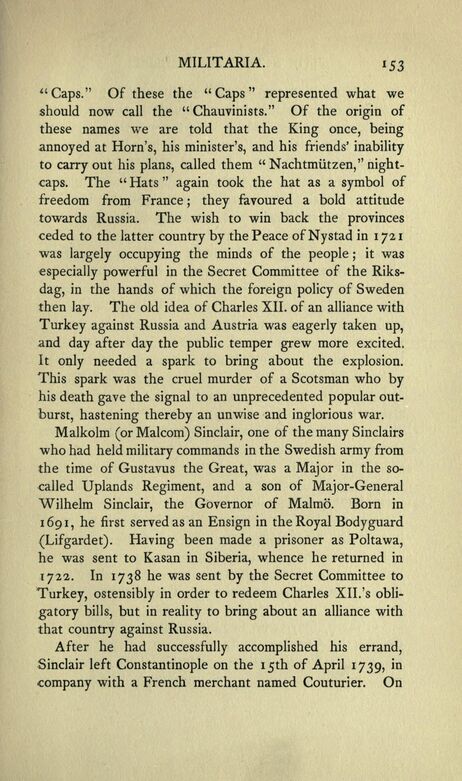
Full resolution (JPEG) - On this page / på denna sida - Sidor ...

<< prev. page << föreg. sida << >> nästa sida >> next page >>
Below is the raw OCR text
from the above scanned image.
Do you see an error? Proofread the page now!
Här nedan syns maskintolkade texten från faksimilbilden ovan.
Ser du något fel? Korrekturläs sidan nu!
This page has never been proofread. / Denna sida har aldrig korrekturlästs.
“Caps.” Of these the “Caps” represented what we
should now call the “Chauvinists.” Of the origin of
these names we are told that the King once, being
annoyed at Horn’s, his minister’s, and his friends’ inability
to carry out his plans, called them “ Nachtmiitzen,”
nightcaps. The “ Hats ” again took the hat as a symbol of
freedom from France; they favoured a bold attitude
towards Russia. The wish to win back the provinces
ceded to the latter country by the Peace of Nystad in 1721
was largely occupying the minds of the people; it was
especially powerful in the Secret Committee of the
Riksdag, in the hands of which the foreign policy of Sweden
then lay. The old idea of Charles XII. of an alliance with
Turkey against Russia and Austria was eagerly taken up,
and day after day the public temper grew more excited.
It only needed a spark to bring about the explosion.
This spark was the cruel murder of a Scotsman who by
his death gave the signal to an unprecedented popular
outburst, hastening thereby an unwise and inglorious war.
Malkolm (orMalcom) Sinclair, one of the many Sinclairs
who had held military commands in the Swedish army from
the time of Gustavus the Great, was a Major in the
so-called Uplands Regiment, and a son of Major-General
Wilhelm Sinclair, the Governor of Malmö. Born in
1691, he first served as an Ensign in the Royal Bodyguard
(Lifgardet). Having been made a prisoner as Poltawa,
he was sent to Kasan in Siberia, whence he returned in
1722. In 1738 he was sent by the Secret Committee to
Turkey, ostensibly in order to redeem Charles XII.’s
obligatory bills, but in reality to bring about an alliance with
that country against Russia.
After he had successfully accomplished his errand,
Sinclair left Constantinople on the 15th of April 1739, in
company with a French merchant named Couturier. On
<< prev. page << föreg. sida << >> nästa sida >> next page >>